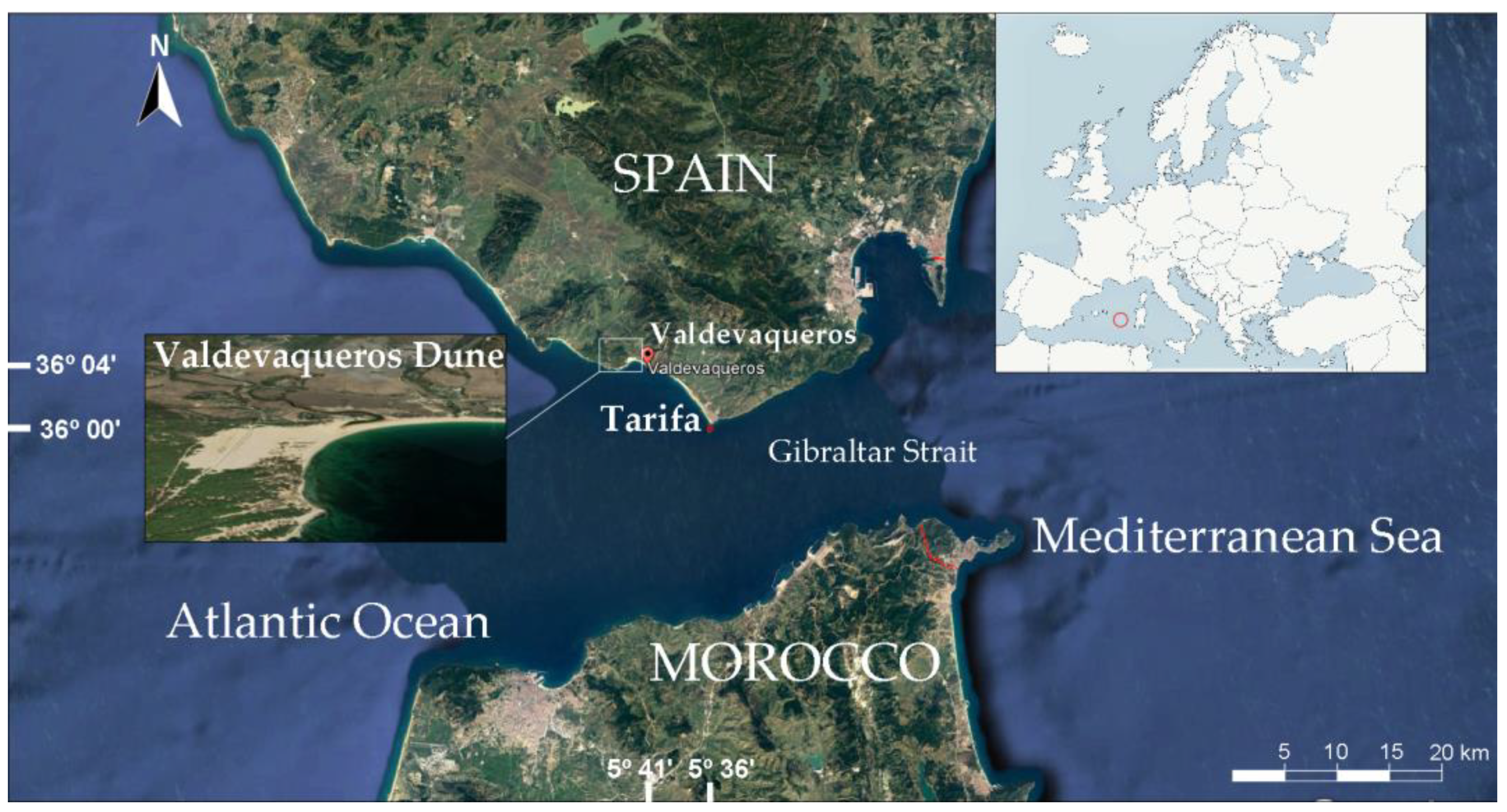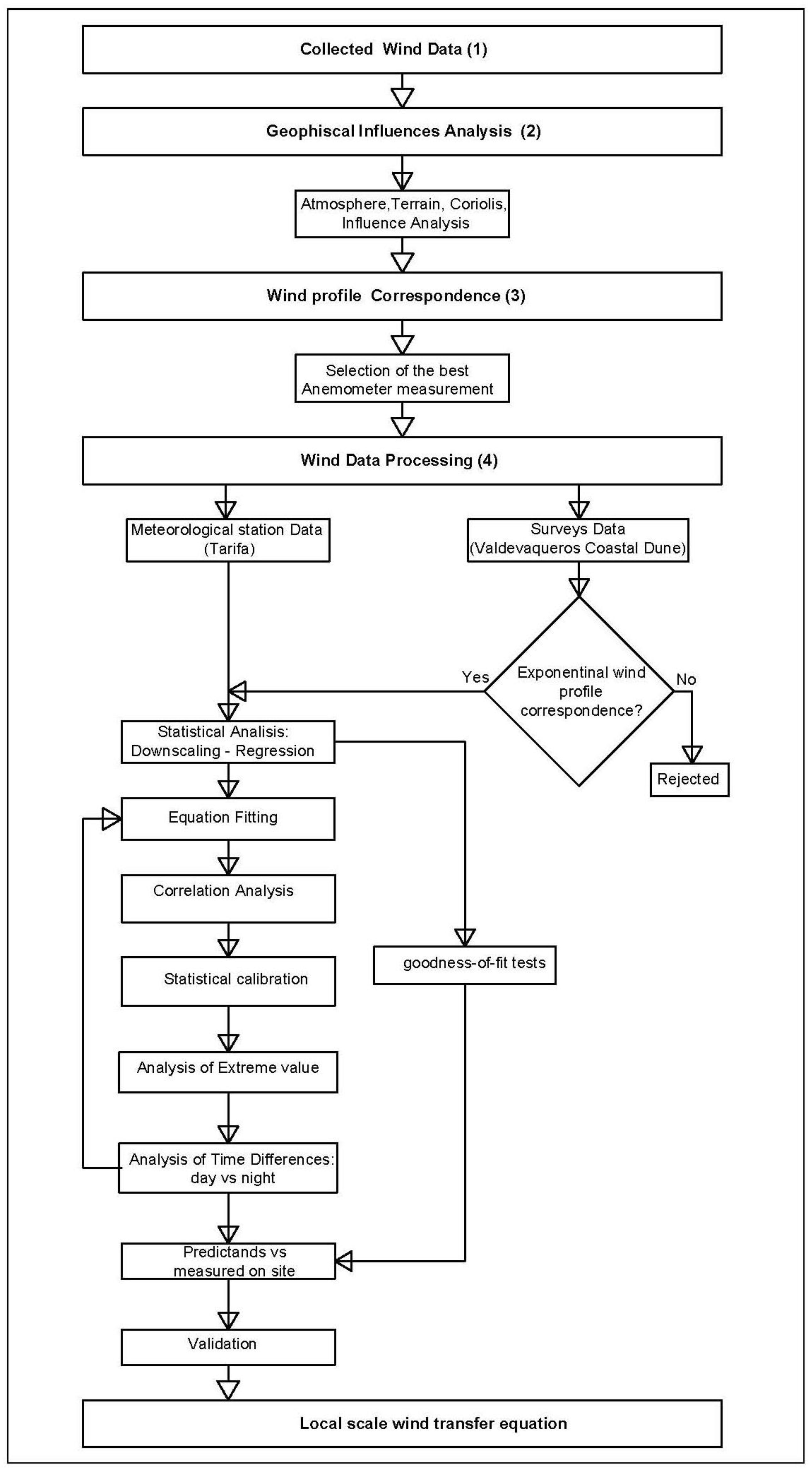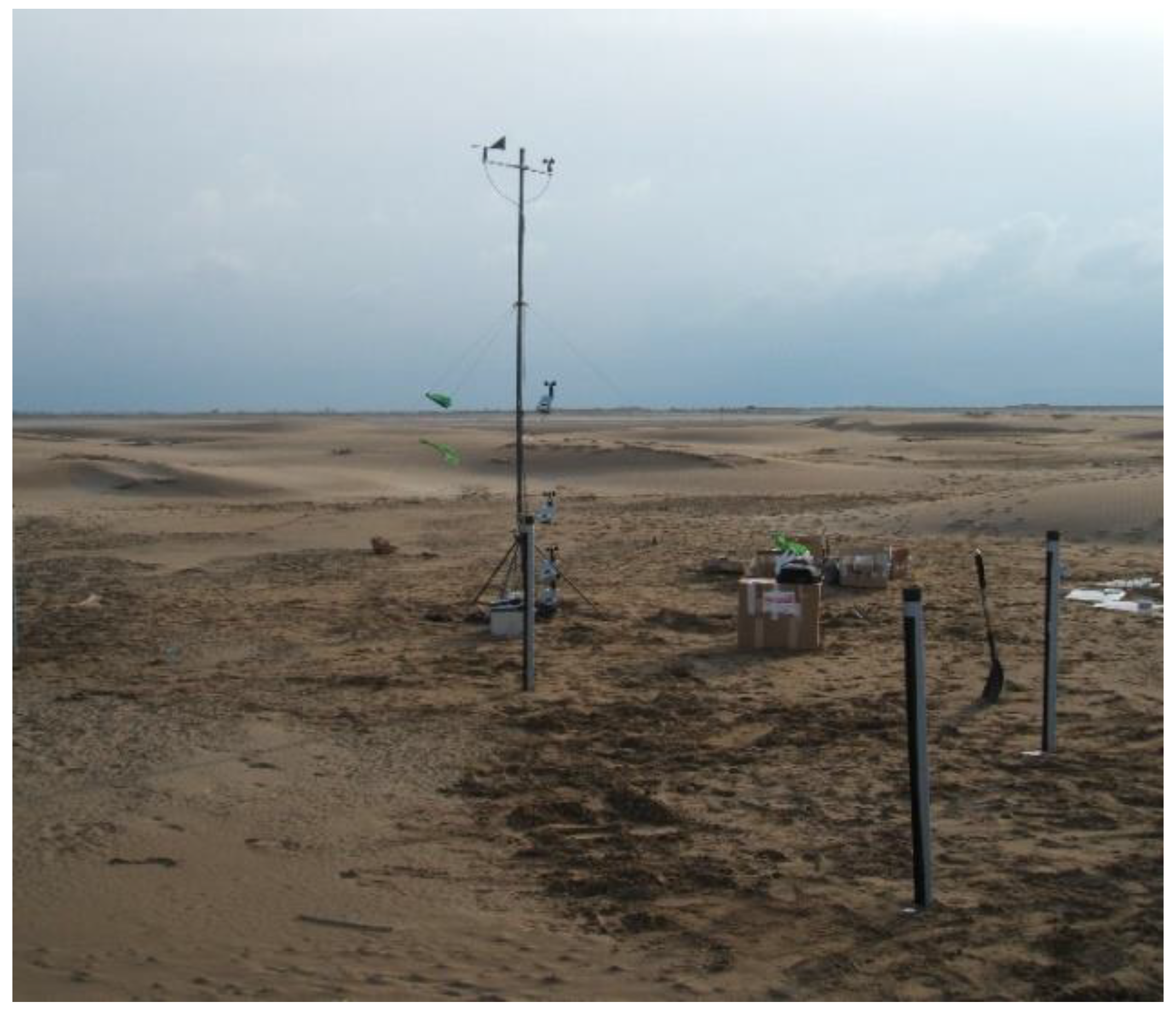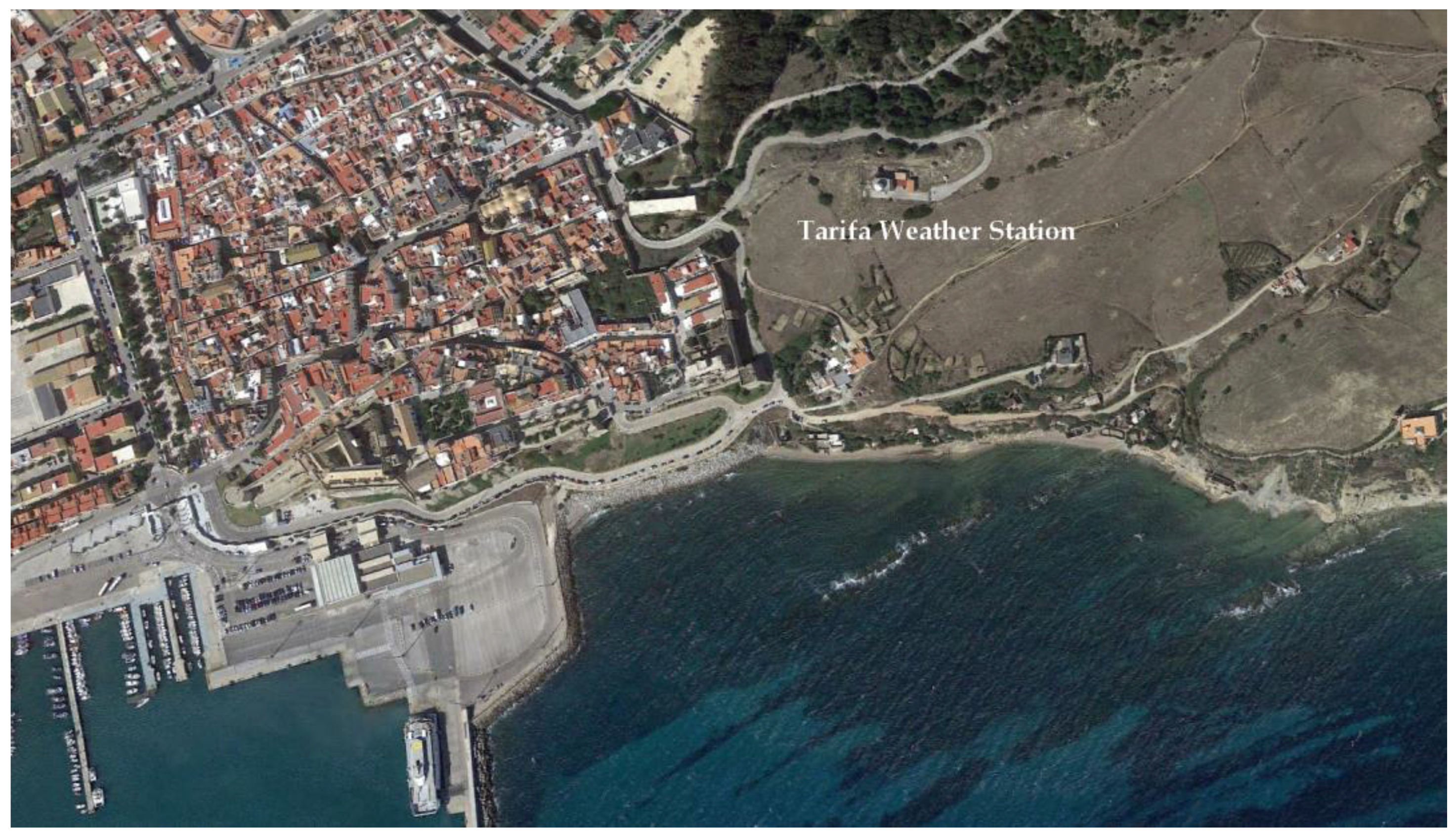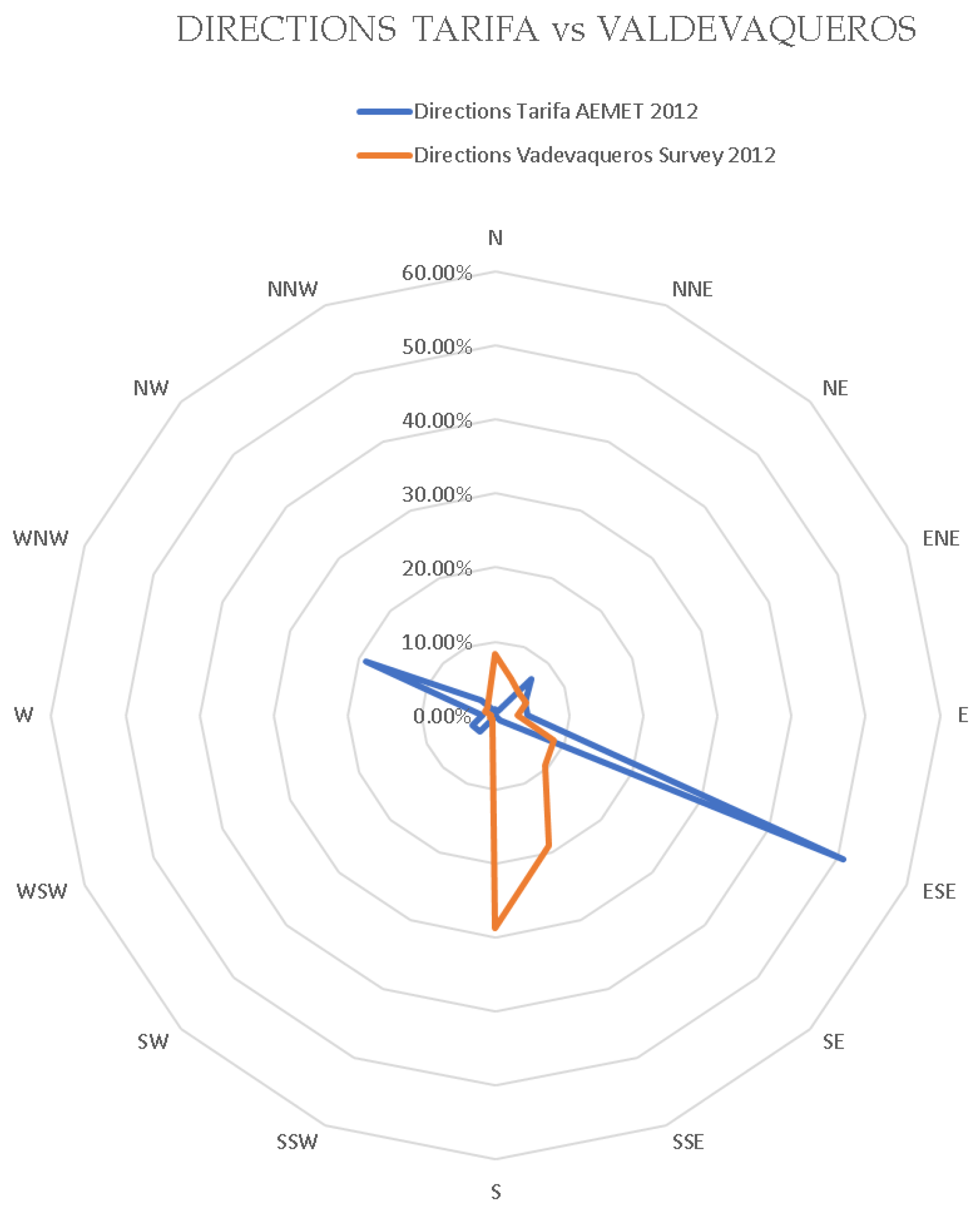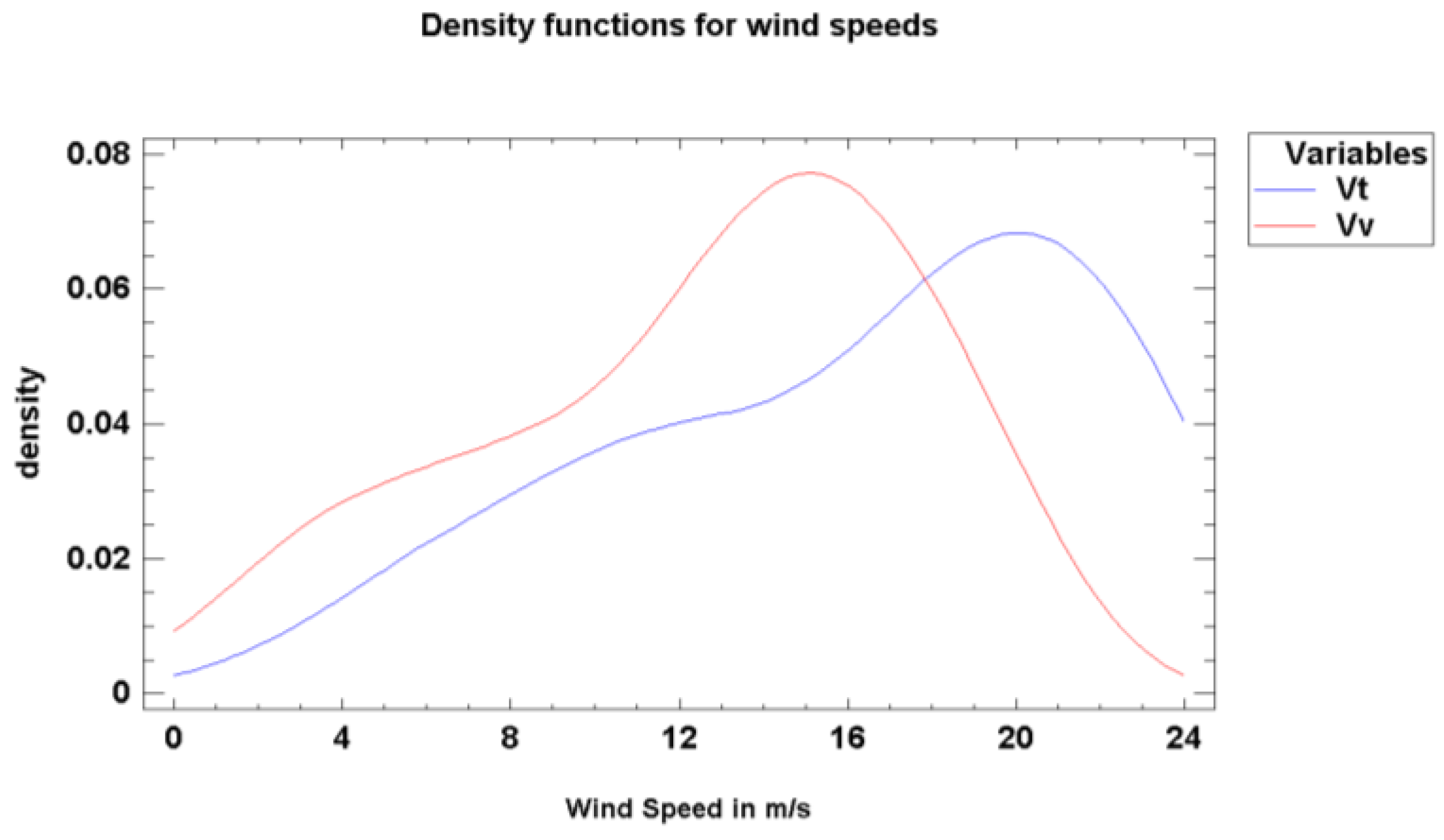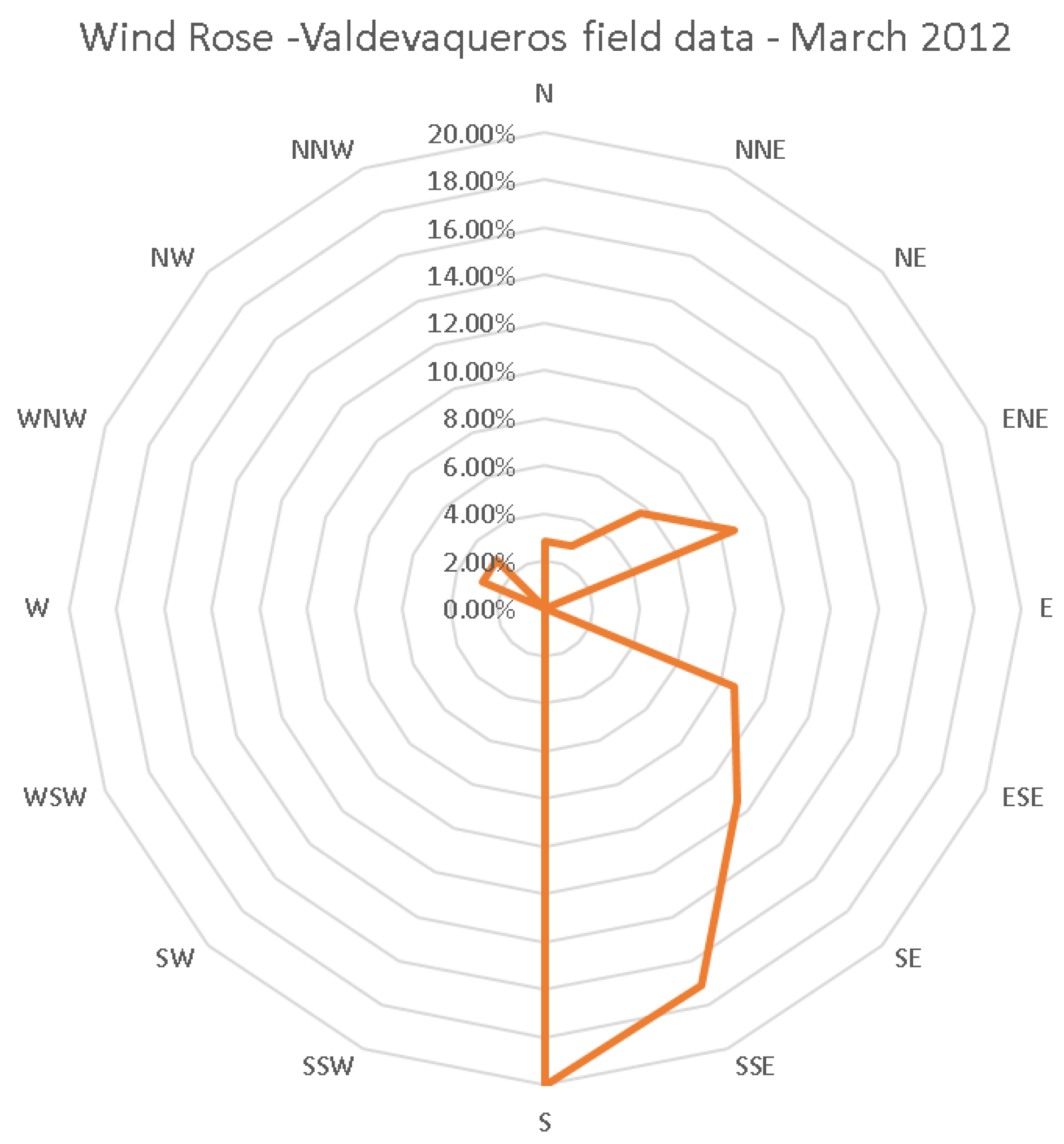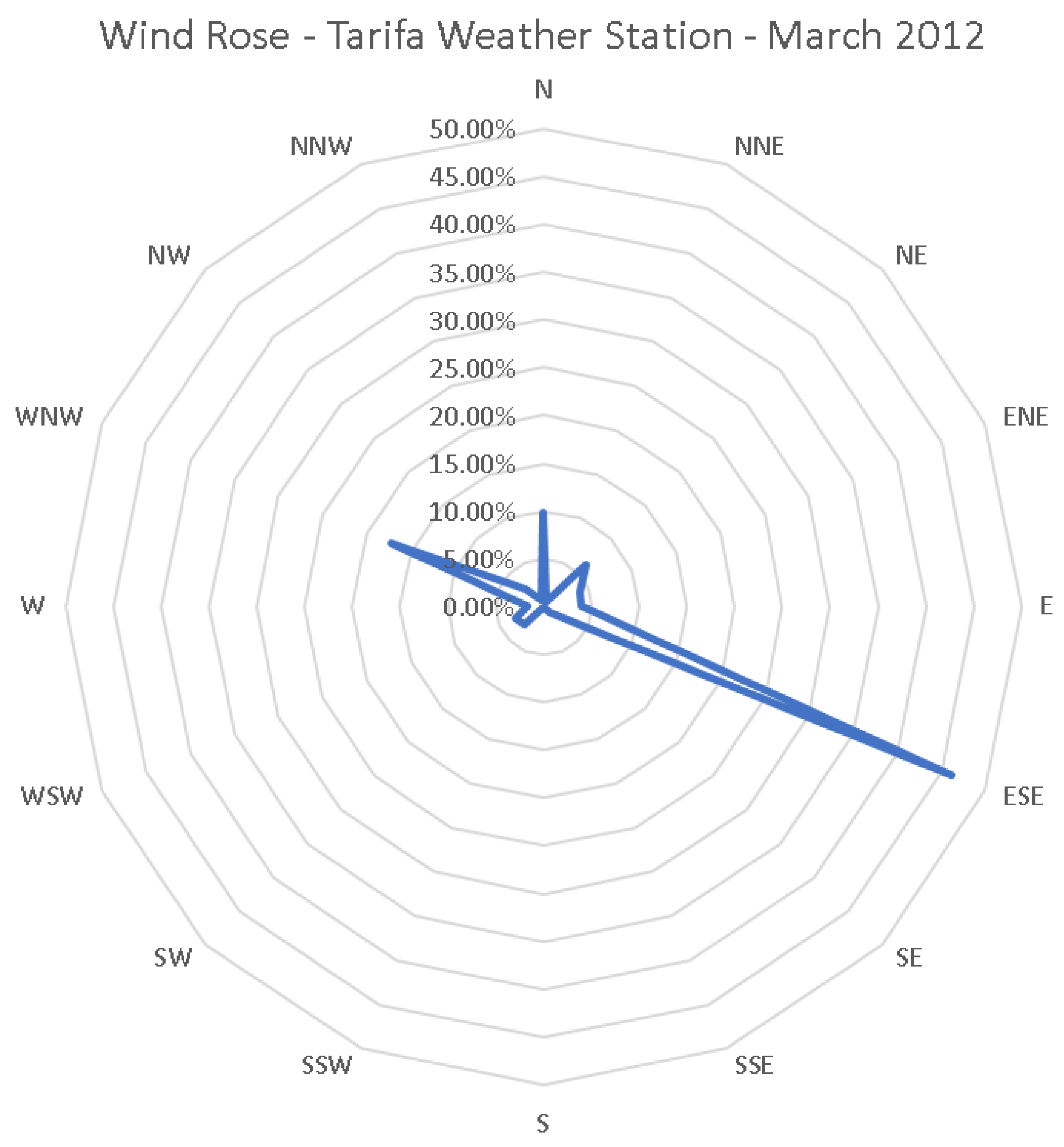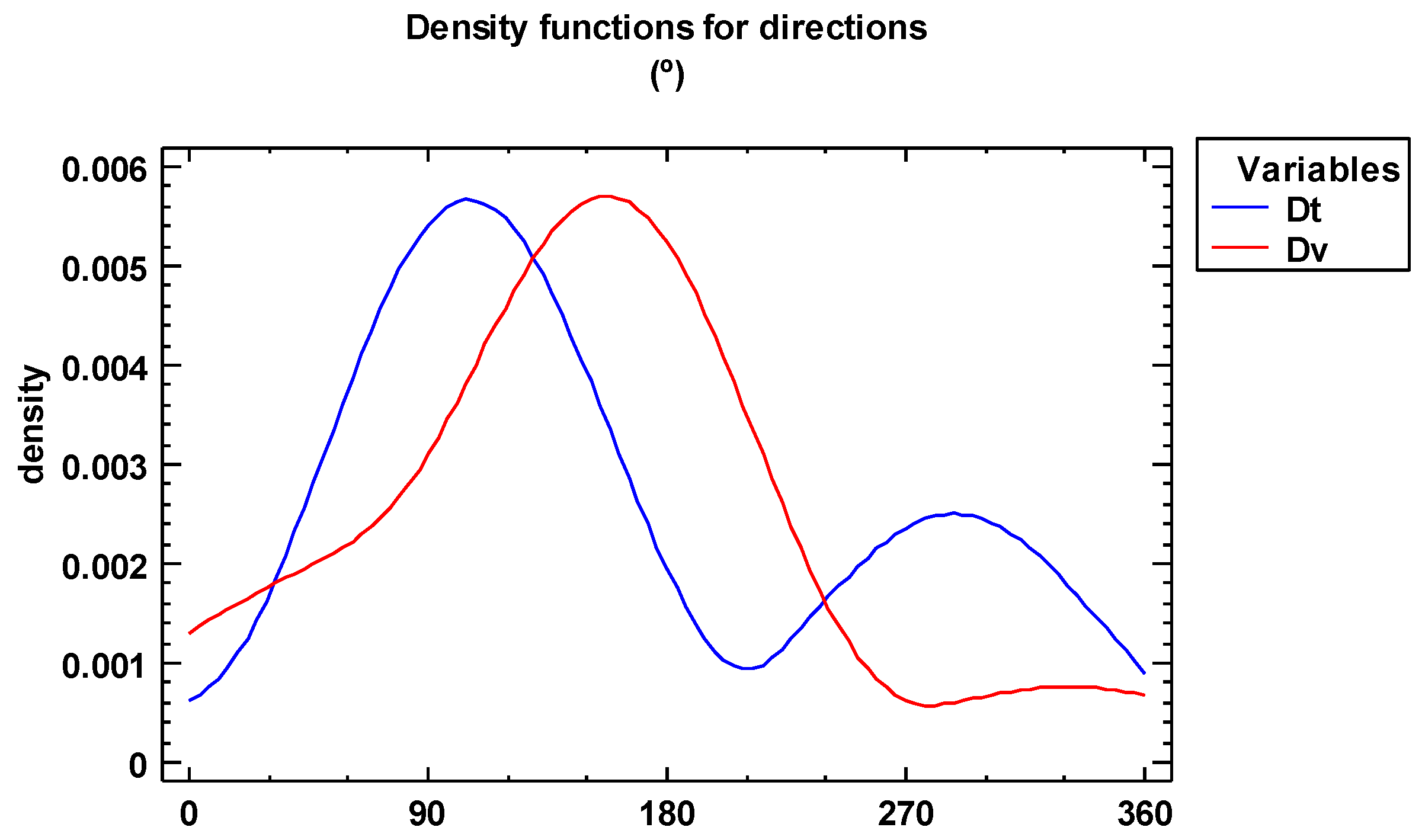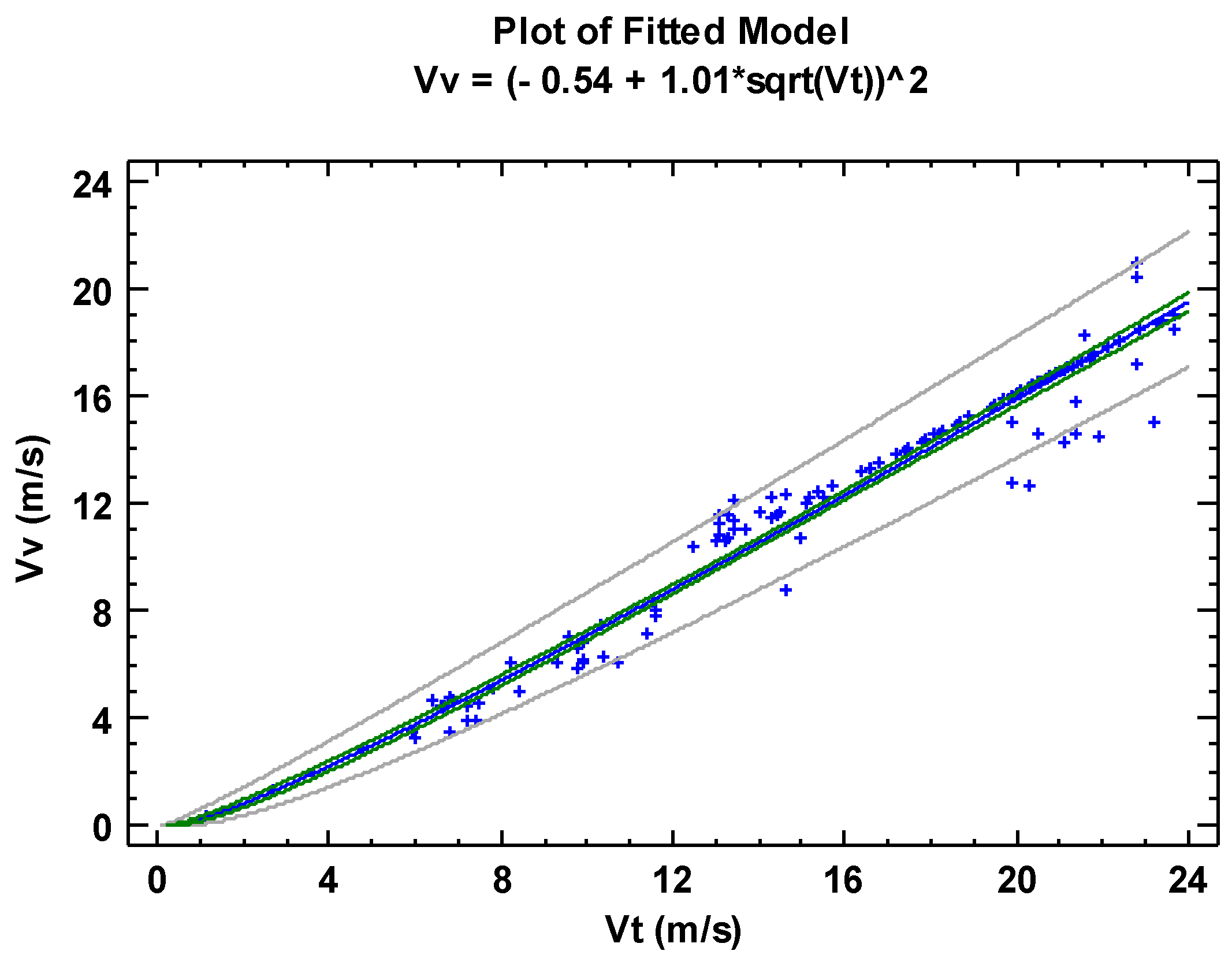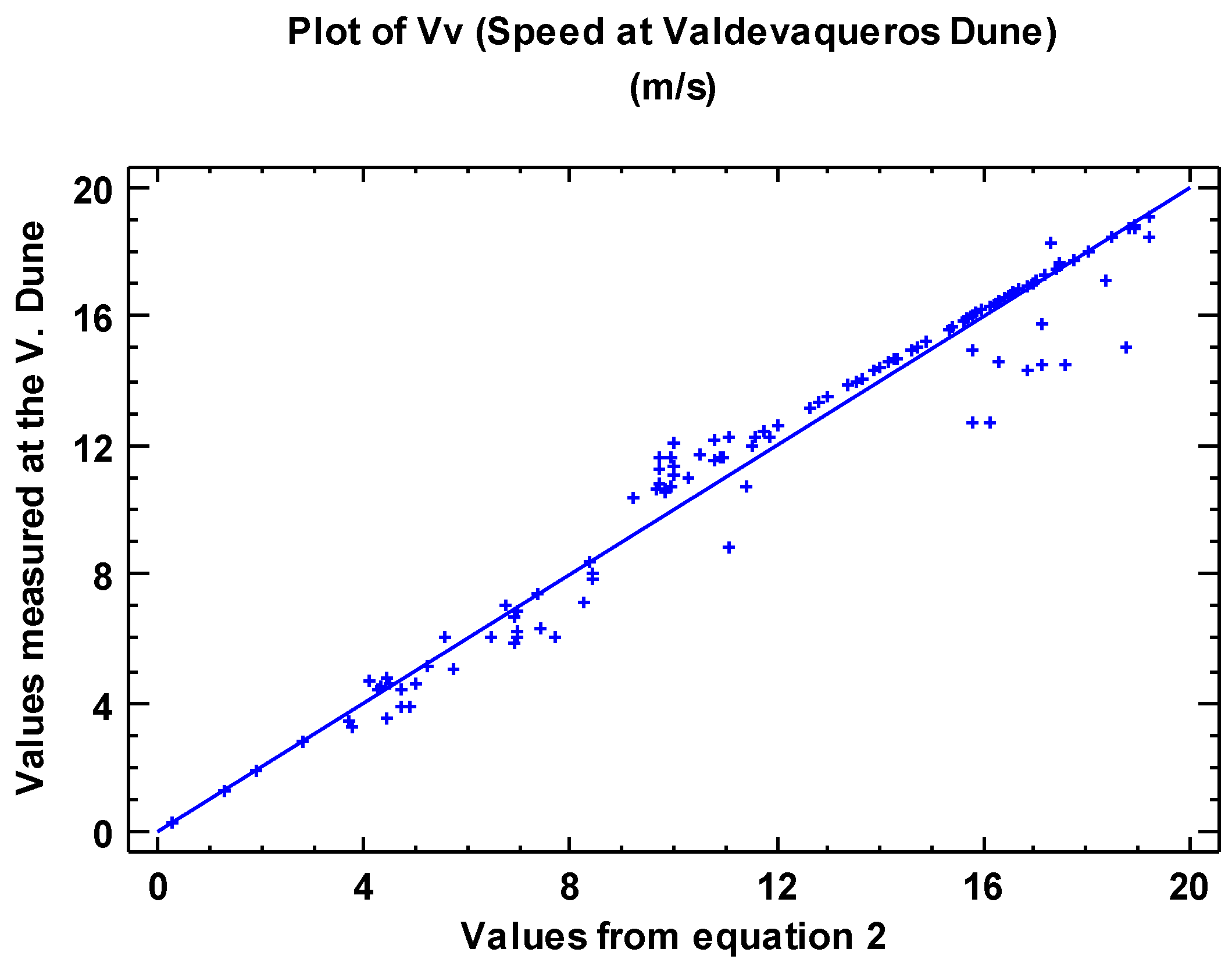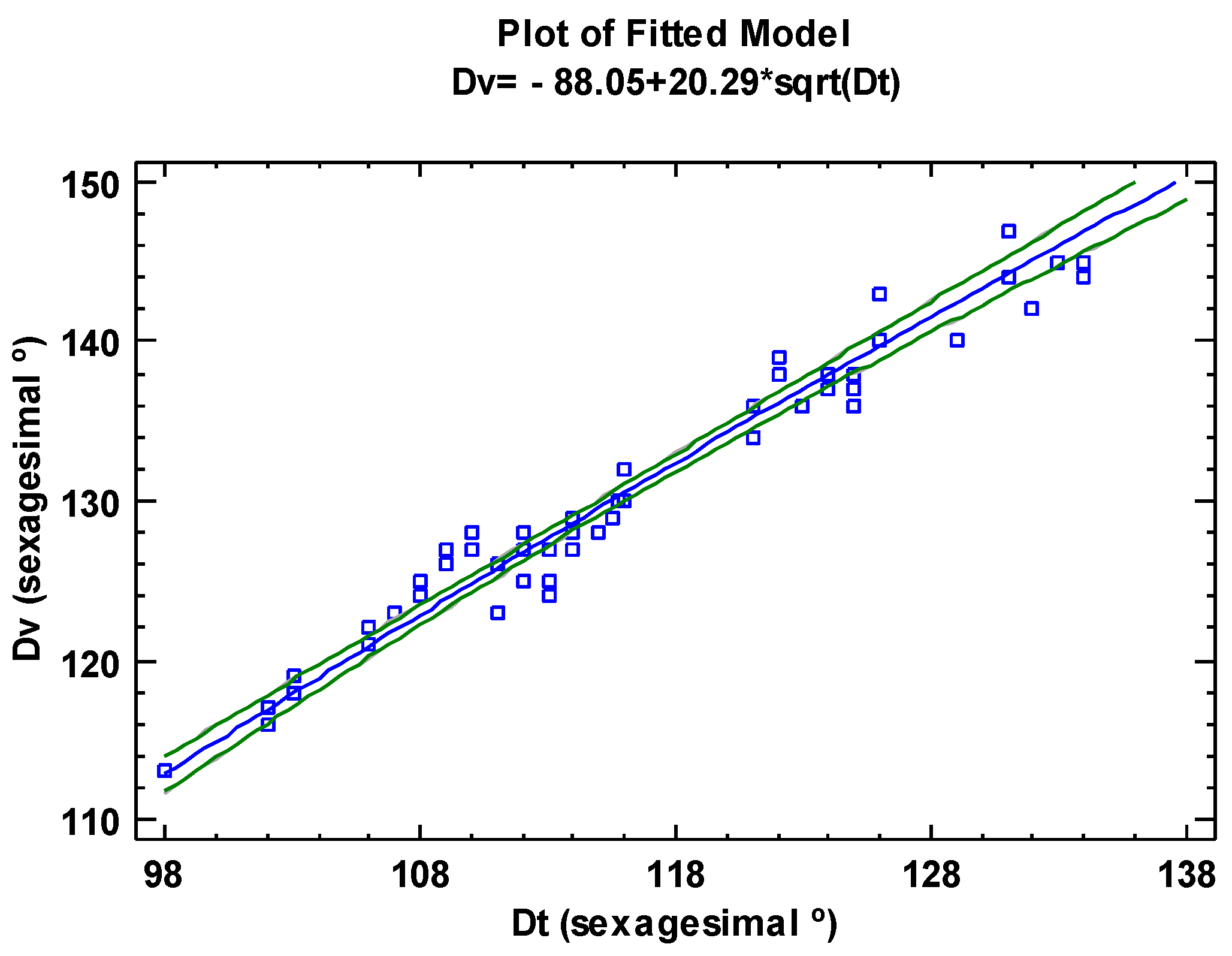1. Introduction
There are different techniques focused on weather prediction, but only a few of them apply to the aims of this study, spatial wind transference at a local scale. Statistical downscaling (SD) is the technique used for reduced areas (up to 10 km) at different time scales (hourly, daily, monthly) [
1]. SD allows for achieving local climate information from coarse scales using analog, regression analysis, or neural network methods [
2,
3]. Another branch of downscaling is dynamic downscaling (DD), but this does not solve the issue of predicting wind in the near field due to different factors such as atmospheric/oceanic boundary conditions, circulation, or limited spatial resolution [
3]. Devis et al. [
4] developed a comparison between these two types of downscaling and concluded that DD is valid for models whose distances are greater than 50 km and have boundaries provided by global circulation models (GCMs).
Although some authors maintain that the achieved results from GCMs are not suitable enough to be used in applications typical at the local scale [
5], SD techniques nested to global circulation models (GCMs) are aimed at weather forecasting at high resolution. They have been improved so much (such as the COSMO-REA6 reanalysis system [
6,
7]), but they are not entirely applicable to the purpose of this article, the spatial transference of wind in a tractable way. However, from GCM experiences, we can take highly developed techniques from SD, such as perfect prognosis (PP) [
2] and model output statistics (MOSs) [
8], which are designed for local predictions from GCMs. The main limitations of both techniques are the relationships between the predictors and GCMs [
2,
9].
There have been some successful examples of the local transference of meteorological phenomena. One such example involved wave propagation on the coastal shoreline [
10]. This study was conducted by the Puertos del Estado (the state-owned Spanish port system,
www.puertos.es). Other examples published by Vidal et al. [
11] and Jigena et al. [
12] analyzed hydrodynamic currents and shoreline changes on Deception Island. From these examples, we can extract the idea of propagation but applied to the wind between two points as a novelty.
The target of this paper is to develop a methodology aimed at achieving the best transference and propagation of wind velocity at a certain point based on the records from a nearby meteorological station, the same idea as wave propagation from deep water to a point near the coast.
Transfer functions are a type of regionalization technique belonging to SD based on the regression relationship between large (>50 km) and local scales (<10 km). This regression enables one to study local weather, but it does not seem that these functions were developed directly from the meteorological data series [
13], and there is no methodology linked to data collection field experiments.
Thus, a methodology to achieve an equation that manages the relationship between meteorological station data and the measured winds in a local area should be developed, e.g., to determine the winds acting over a coastal dunar system. However, such a method could also be extrapolated to other systems under the same conditions, such as harbors, shorelines, other coastal dunes [
14], wind farm foundations [
15], and beach geomorphology [
16].
Because the available data are taken from field experiments carried out specifically in situ and from a nearby meteorological station, this study focuses on achieving a wind transfer function and proposing a corresponding methodology. This goal was possible using regression methods and the wind profile theory (power law) [
17]. The power law can be applied to estimate the vertical wind profile using the roughness characteristics of the site [
18]. Both the regression methods and the wind power law are used here to develop an equation for wind speed. The same procedure is used to determine the direction relationship. In other words, we use the SD ideas to develop a method to propagate wind.
2. Study Area
The study area is a coastal dune located in Valdevaqueros (Cadiz) on the southernmost point of Spain (Gibraltar Strait). The base data are meteorological data from Tarifa (Cádiz) and a 2012 field experiment carried out at the dune. The Valdevaqueros Dune (Cádiz) is approximately 10 km away from the meteorological station of Tarifa. The meteorological station of Tarifa is located on a promontory above the port basin and is managed by the Spanish Official Meteorology Agency (AEMET,
www.aemet.es, accessed on 16 April 2023). The elevation (altitude) of the ground level at the Tarifa station is around 32.00 m above mean sea level (a.m.s.l.), which is used as a vertical datum for this research.
Figure 1 illustrates the study site and shows the relative location of the meteorological station of Tarifa and the Valdevaqueros Dune.
This dune is in one of the windiest points in Spain. The system is formed by accumulations of sand that migrate from the beach due to intense easterly winds. The result is a sand formation oriented to the NE-SW, as
Figure 2a,b show. Its dynamic is causing a relevant impact from a scientific and social point of view [
19]. Here, the frequent occurrence of easterly winds has generated a highly mobile dune [
20]. High sand migration rates occur in the dune because 70% of the wind speed exceeds the threshold velocity for sediment. The climatic conditions are unique for this area [
21], mainly due to the presence of a long shoreline (more than 40 kilometers) and a cove before reaching the dune. This stretch of shoreline is only interrupted when the lagoon of the Valle River connects with the sea during the great floods [
20]. The wind-blown sediment is a well-graded material composed mainly of quartz, with an average sand size of 0.3 mm [
21,
22].
The chosen study area is the Valdevaqueros Dune because it experiences a displacement of up to 1 m per day due to the eastern wind. The existence of a weather station (Tarifa) close to the dune and a predominant wind component from the weather station to the dune made us consider this place suitable for developing the methodology to propagate the wind from one point to another. Last, the dune advance is quick, and the sands are constantly invading the only road that connects to the rural settlement of Punta Paloma [
23,
24,
25], as shown in
Figure 2c. This transfer equation intends to be an additional tool in understanding how the movement is produced.
4. Results
The data from the anemometers had to be processed and fitted with data from the meteorological station of Tarifa in order to align the correspondence between sampling frequencies.
Figure 6 shows the different directions between the two measurements.
Before detailing the obtained results, we conducted a comparison between the collected data. The model has been trained (calibration) using the data from the field experiment carried out in March 2012, and it has been validated according to the data from the field experiment from October 2012.
Figure 7 depicts the comparison between the two samples, where
Vt is the wind velocity at Tarifa (predictors) station, and
Vv is the wind velocity at Valdevaqueros Dune (predictands).
Regarding the wind directions, the values measured at Valdevaqueros indicated higher variability than those at Tarifa Station. Therefore, there is no main prevailing direction, but the east and south are the most representative directions overall.
Figure 8 reflects the randomness of the directions measured at the coastal dune in March 2012.
The prevailing direction at Tarifa is east–southeast, with a few variations turning around the north and west, which barely represent around 20% of the historical data.
Figure 9 outlines the frequency of wind directions at Tarifa in March 2012.
East wind components predominate in the area, with a trend of changing wind from north to east–south. In both samples, the E–S wind component comprised 51% of the accounting records. The maximum values corresponded to the E–S direction, with higher values recorded for the ESE component.
Figure 6 and
Figure 7 show the changes in wind direction from Tarifa to Valdevaqueros because of the coast orientation.
Figure 10 depicts the differences between the density traces of both samples, where
Dt is the wind direction at the Tarifa (predictor) station, and
Dv is the wind direction at Valdevaqueros Dune (predictand).
In a first approximation, we compared the anemometer data with the ones from the meteorological station of Tarifa. The aim was to determine the preliminary results obtained only by regression techniques without considering the power law application. Afterward, both outcomes, preliminary and final, were compared. The point here was to demonstrate that we can directly know which anemometer height fits better with the power law use. This saves an arduous, even difficult, process of fitting the data from each anemometer.
Table 6 shows the average correlation and determination coefficients for different regression models in an exploratory stage.
According to the methodology proposed above, two equations were used to correlate data from the two locations. These functions established the relationship between the speeds and directions of the winds measured at the Valdevaqueros Coastal Dune and the Tarifa meteorological station. The procedure to obtain the equations was SD. Specifically, we used downscaling based on regression [
41].
A regression study was conducted using Equation (1) to obtain the best fit between the wind profile and the anemometer measurements. We took the values from the anemometer as a reference, and we applied the wind profile law. After that, we compared the results with data from the Tarifa station. The aim was to choose the best measurement to compare against data from Tarifa and thereby obtain equations with maximum accuracy.
Table 7 shows the correlation coefficient (R) and determination coefficient (R
2) for both locations.
Comparing
Table 6 and
Table 7, we can show that by applying wind power law, we directly obtain the same results as we achieved with a hard regression process.
The previous table indicates that the data measured at a 1.00 m height have a better correspondence with the values obtained via the Hellman equation. Additionally, the regression study indicates that measurements at this height provide the best results.
Once we determined that the data from the anemometer assembled at 1.00 m in the Valdevaqueros Dune had the best regression coefficients, we began the process of realizing the transfer equations. The results are outlined in three subsections, one for the speeds, the other for directions, and a subsection for the validation of the model.
4.1. Transfer Function for Wind Speeds
As indicated in the methodology, although the logarithmic profile also fits well, the wind profile power law was superior, with higher accuracy and a better correlation for this location, as the area did not play an important role in this study because the wind fields are given from Tarifa weather station, and the aim was to obtain the best correspondence between data. For other sites, multiple assessments should be performed to choose the best profile. In this case, the surrounding area was deemed unimportant for the transference of wind since this parameter does not intervene in any case.
The results for the tests of K-W and M-W (0.23 and 0.18, respectively) allowed us to ensure that there was no significant difference between the medians of velocity from the anemometer measurements and the data from Tarifa.
Linear regression [
42] was used to obtain the expression for the predictors and predictands. In the ANOVA test, high percentages were obtained for the correlation with the velocity.
Table 8 shows the correlation values for linear models with percentages above 95%.
In light of the results, we selected our model based on two goals: (1) obtaining the most accurate fitting and (2) obtaining a tractable mathematical expression. For this purpose, we selected the double square root model (Y = (a + b·√x)2).
Thus, the transfer equation to propagate the wind speeds from Tarifa Station to Valdevaqueros Dune was constructed via linear regression after transforming to a logarithmic scale to linearize the model by least squares fitting:
where
Vv is the predictand for the velocity at the dune and
Vt is the predictor (values measured at the meteorological station of Tarifa) with the coefficients in
m/
s. The ANOVA test yielded a value lower than 0.05 for fitting the coefficients a (−0.54) and b (1.01). The R-squared result indicated that the chosen model could explain 96.98% of the variability in speed. The correlation coefficient was 0.98, indicating a strong relationship between the variables. The standard error of estimations is 0.14, and the mean absolute error is 0.09. These results demonstrate that the methodology presented here can obtain a highly accurate mathematical expression.
Figure 11 provides a graph illustrating the values resulting from Equation (2).
The gray lines indicate the confidence range (95%); this is the range of values that we expect the predictands to fall. The green lines indicate the prediction limits (95%), the range of values that will likely contain a future prediction. The confidence range and prediction limits are computed using the mean and standard deviation, mean squared error (MSE), and the critical values for the statistical test applying normal distribution [
43,
44,
45]. Equations (3) and (4) show the general expression of a confidence range:
where
CR is the confidence range,
PL is the prediction limits,
is the sample mean,
Z is the critical value of the
z distribution,
s is the sample standard deviation,
n is the sample size, and
z is the corresponding quantile of the normal distribution.
Finally, we carried out an analysis of the results. The values from the equation were compared with the values from the field experiments (data from the anemometer placed at a 1.00 m height). To evaluate the model, we used the leverage parameter [
46]. This parameter measures how influential each observation is in determining the coefficients of the estimated model. In this case, an average data point would have a leverage value equal to 0.015. This indicates that there are no important deviations from the measured data from the dune.
Figure 12 illustrates this comparison.
4.2. Transfer Function for Wind Directions
The process to obtain the transfer function for directions is the same as that used for the speed values in
Section 4.1; to avoid repetition of the mathematical steps, a summary of the design criteria, input data, and the results are provided.
The function lets us know the wind direction in Valdevaqueros with previous data from Tarifa. This is the propagation of wind direction data from Tarifa, but only those that reach Valdevaqueros. This implies that this equation is only able to transfer data in those directions, from the Tarifa to Valdevaqueros, and not the other way around. Thus, the equations provide data for the directions input from ENE to SSE, being this the wind directions that reach Valdevaqueros from Tarifa. This feature of the function is aligned with these directions, corresponding to the maximum speed, and they produce the maximum movement in the dune.
Table 9 shows an example of the average directions taken every 10 min, used to determine the direction transfer function.
Inference for regression is applied due to its usability. Correspondence between directions requires a different type of regression than the linear type. For the directions, the correlation is not as direct as that of the velocities. This variability is shown in
Figure 5 (wind roses comparative).
After different linear and polynomial regression trials, the best way to fit the relationship was determined to be orthogonal regression [
47,
48,
49,
50,
51]. The main difference between the least squares, used for speeds, and the orthogonal regressions, for directions, is the way to minimize the distance to the fitted line (vertical in the first one and perpendicular in the second one).
Table 10 shows the correlation values for orthogonal regression models with percentages above 95%.
This analysis is identical to that presented in the previous paragraph. Equation (5) is based on the same model as Equation (2) (Y= (a + b·√x)
2):
where
Dv is the predictand for the direction at the dune, and
Dt is the predictor (measured values from the meteorological station of Tarifa). Both are expressed in sexagesimal degrees (°).
Table 11 shows the error for the coefficients:
Figure 13 graphs the resulting values from Equation (5). The gray lines indicate the confidence ranges (95%), and the green lines indicate the prediction limits.
4.3. Model Validation
As indicated in the previous paragraph, the model has been trained with the data from the field experiment carried out in March 2012. In order to validate the achieved transfer functions, data from the field experiment carried out in October 2012 has been randomly chosen to check the models.
Table 12 shows the results and the error with respect to the measurement. The directions have been checked only for the direction in Tarifa, which take relevance in Valdevaqueros (ESE-SSE).
As the data were collected each minute at the dune and every 10 min in Tarifa Station, the input data in
Table 12 are the average of the corresponding 10 values for the Valdevaqueros Dune. This is the way to compare data in the same conditions. The average error for speeds and directions is around 4% and 5%, respectively, removing the outliers.
5. Discussion
Based on the above equations and their results, although the fitting provided a high correlation, the calibration process should continue in future work. The field experiment data were enough for developing the methodology and testing the model, but it is necessary to carry out new data collection on site. This will be performed in future works with the double aim of ensuring the representativeness and resilience of the equations against the unsteady atmospheric processes. This would also greatly increase the validity of the developed function, as it would potentially show that the data used for March and October 2012 were similar over several years. However, this trend is shown in
Table 5 for the period from 2012 to 2013. In addition, this future work will compare the obtained results by our spatial transfer functions with the GCMs, especially with the COSMO-REA6 hindcast. This GCM is chosen because it is a reanalysis system that operates with dataset features a 6 × 6 km horizontal resolution from 1995 to 2019. This comparison is geared to cross-check against the results from both transfer equations and GCMs at a local scale. The aim is to verify and/or improve our functions as well as validate the accuracy of GCMs in this regard.
One further point to be studied is the splitting of the transfer function for velocities in stretches covering different ranges of data. An open hypothesis is whether one can obtain a function for the medium values and another for the extreme values in order to further improve the current results. The same question could be applied to directions far from the predominant direction (ESE), although such directions represent less than 10% of the sample. In this case, we could split the equation into three stretches, as proposed for the modules, with one for the N-E range, another for E-W, and the last for W-N. Placing the focus on the prevailing wind direction rather than the other directions has facilitated the search for relevant equations.
It is also important to remark upon the high values of these coefficients. The core element was the introduction of the wind profiles in the investigation.
6. Conclusions
This paper aimed at resolving the lack of methods, using a relatively simple technique, for wind transference/propagation at a local scale. Most local predictions are based on GCMs, but their design is suitable for global weather forecasting and climate change. However, GCMs can be run at a local scale, but they need a huge amount of data for reanalysis and assumptions that sometimes may lead to more uncertainties and limitations of the results at this spatial resolution. SD is increasingly applied to develop local climate information from the GCM resolution. This work explores the way to carry out wind propagation based on locations with wind serial data information not further than 10 km.
The proposed method is based on a comparison between the power law and data collected on site. This led us to select the most suitable wind data between 4 anemometers assembled at different heights from a field experiment. These data were then matched with data from a nearby weather station. The area is influenced by a strong eastern wind component.
Another important aspect of this investigation was the application of the power law (wind profile) to select the best data from the field experiment. This process indicated that data from the anemometer assembled at a 1.0 m height were better to compare against data from the station of Tarifa. This means the functions to propagate (transfer) winds have been developed considering the data from Tarifa and the anemometer at 1.0 m height.
After analyzing the methodology and its results, we found that the achieved transfer functions allowed us to determine the winds acting on the coastal dune of Valdevaqueros, for speeds and direction from ENE-SE, with an average error under 5%.
In the end, high correlation values confirmed a suitable fit between the data. The accuracy of the equations was also high according to the R values (≈0.98) for both velocities and directions.
Finally, this methodology should be feedback with new data from longer field experiments and evaluated on other sites in order to obtain the physical interpretation of the parameters of the transfer functions beyond the mathematical sense and continue improving the fit. Furthermore, future works will be carried out to check GCMs versus these transfer functions in order to improve the proposed local model and explore the possibilities joined with GCMs.
